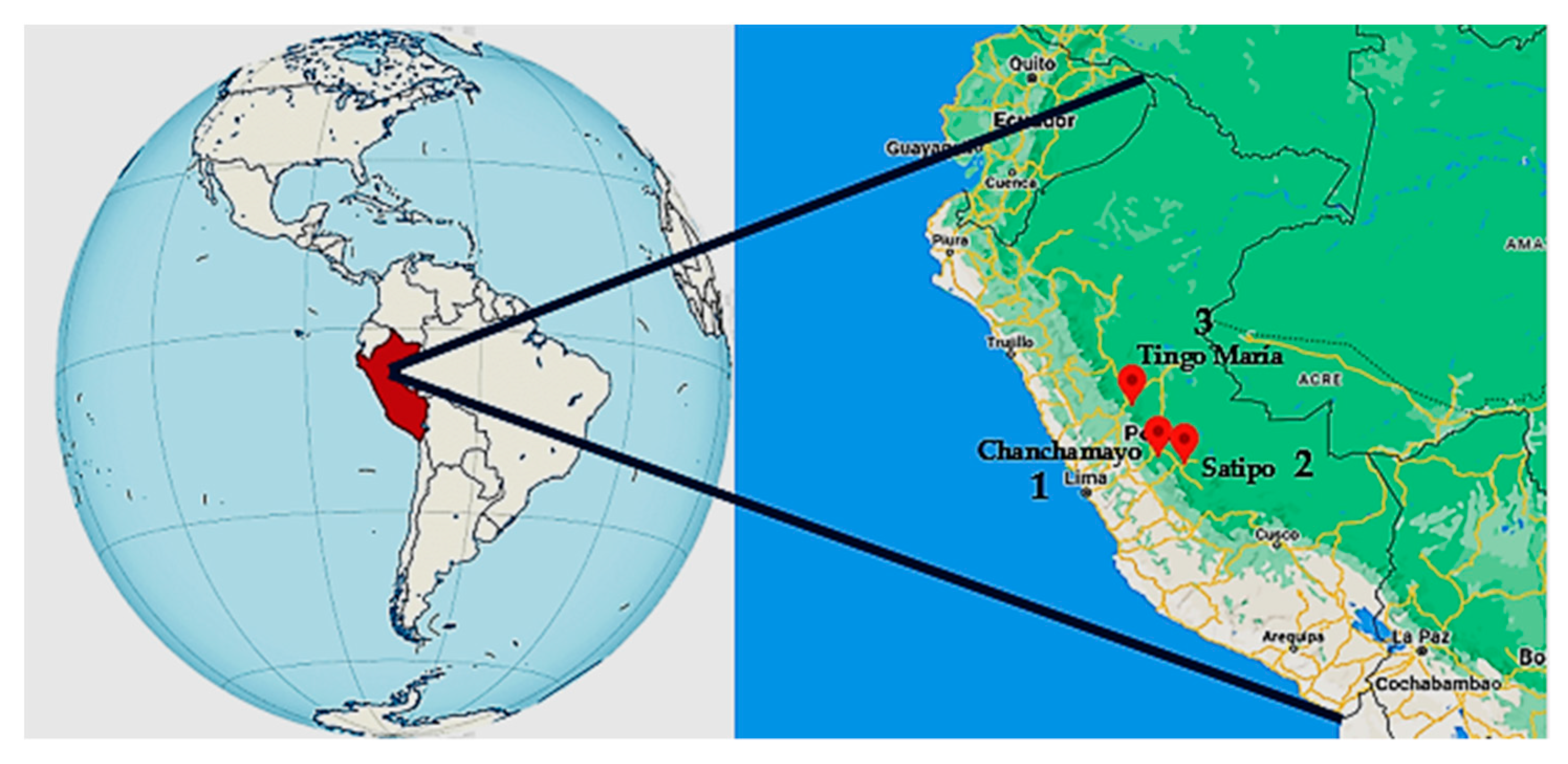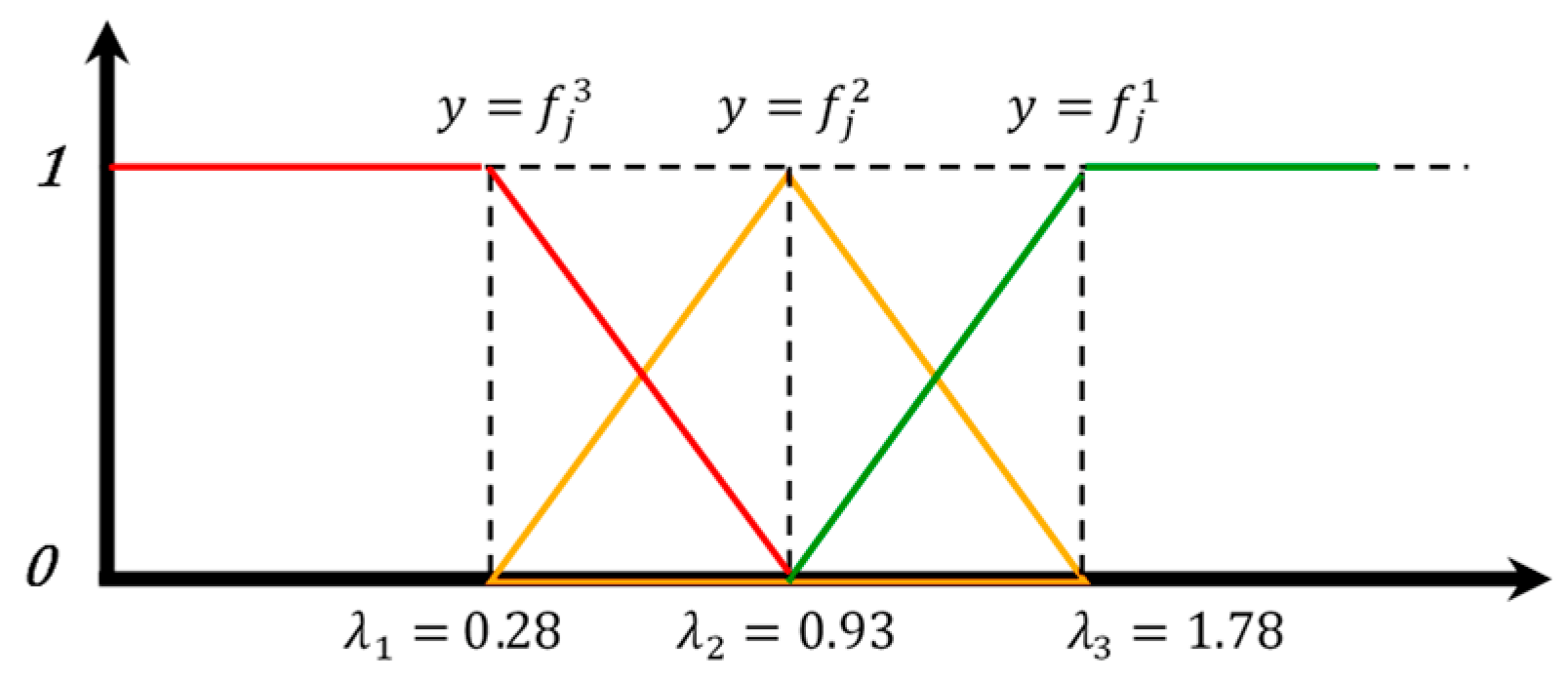1. Introduction
According to WHO, health risks in the workplace, including heat, noise, dust, hazardous chemicals, unsafe machinery, and psychosocial stress, cause occupational illnesses and can also aggravate or lead to other health problems [
1]. Nowadays, the importance of safeguarding workers’ health and safety has been widely accepted within companies and institutions [
2]. However, at a general level, there is no method that integrates the different types of risks, even though it is necessary to have indicators of health and safety management through comprehensive risk assessments; therefore, this paper proposes a model to integrate this risk by applying the grey clustering method [
3]. In this sense, the present study evaluates the risk level of hygiene quality in three different contexts in Peru (Chanchamayo, Satipo and Tingo Maria), analyzing the warehouse area of a company from the beer sector. This company has three decentralized beer production plants which are allocated in the central region of Peru, in which the level of exposure to physical agents such as lighting, heat stress, noise and vibration are present during work activities.
In turn, there are approaches to access occupational risks, such as the Delphi method, as shown in work on occupational challenges [
4], the AHP method, as shown in research work on a safety evaluation model [
5], or the Fuzzy AHP method (FAHP), as shown in work on a two-dimensional fuzzy risk assessment model [
6]. Among the methodological alternatives available to quantify the qualitative information during the occupational risk assessment, the grey clustering method is considered a good alternative, as it considers uncertainty in the analysis [
7]. The grey clustering method is based on grey systems theory, which is an approach from artificial intelligence theory as shown by Liu and Lin in their work entitled Grey Systems Theory and Applications [
8,
9]. In addition, the grey clustering method was previously used in different areas such as industrial hygiene [
3], social conflict [
10], air pollution [
11] and air quality [
12]. In this work, the “Center-point Triangulation based on Whitenization Functions” (known as CTWF), which is an approach from the grey clustering method [
7], was applied, since it is mainly applied to test if the study groups belong to predetermined classes known as grey classes [
12] and can operate with a degree of uncertainty in circumstances where limited data are available [
3].
In addition, the novelty of this work is the integration of industrial hygiene agents for the first time, which allows the building of an index to measure the quality of industrial hygiene management. Furthermore, from the computational point of view, this work uses an approach based on the grey systems theory that allows the considering of uncertainty within its analysis.
Hence, the specific objective in this work is to apply the grey clustering method in the integral risk assessment of three warehouses of a beer industry in Peru to better understand the scenario and give the recommendations accordingly, regarding the control measures. In addition, the level of risk for each agent is analyzed to obtain an overall risk assessment of these factors.
This work is organized as follows:
Section 2 presents the methodology, followed by
Section 3 in which the case study is developed.
Section 4 provides the results and discussion, and finally
Section 5 evidences the conclusions.
2. Methodology
In this section, the grey clustering method is explained according to its different steps; it is important to highlight that this methodology was developed to classify observation groups into definable classes, and can be performed by means of whitenization functions [
13]. Such functions are mainly used to check whether the observation groups belong to predetermined classes, and conclusions based on this cognitive certainty could be more reliable [
12].
The CTWF method can be described as follows: first it is necessary to assume that there are a set of n groups (
a set of m criteria
and a set of s grey classes
according to the sample value
, and then the steps of the CTWF method can be developed as follows [
13]:
2.1. Determination of Central Points
The intervals of the criteria are divided into s grey classes, and then their center-points λ1, λ2,…, λS are determined from the standard data.
2.2. Dimensionless
The standard data are dimensioned using the arithmetic mean of the central points (λ
1, λ
2,…, λ
S) found in step 1 of each criterion
j (
j = 1, 2, ..., m); then, each central point λ
S of each criterion is divided by its respective mean, which is calculated using (1).
2.3. Whitenization Functions and Their Values Determination
The grey classes are expanded in two directions, adding the grey classes
and
with their center-points
and
, respectively. Thus, the new sequence of center-points is
, (see details in
Figure 1).
For the
grey class,
of the
criterion,
, for an observed value
, the CTWF is calculated by (2).
2.4. Weight of the Criteria Determination
The weight of the criteria is determined by the harmonic mean; first, the inverse of the standard dimensionless data must be determined and divided by the sum of the inverses found, as shown in (3).
2.5. Determination of the Clustering Coefficient
The comprehensive clustering coefficient
for group i, in which
, in the grey class
, is calculated by (4).
where
is the CTWF of the
grey class of the
criterion, and
is the weight of criterion
[
7].
2.6. Analysis of Results Using the Maximum Clustering Coefficient
After calculating
, the maximum grey cluster coefficient is determined using (5) [
14].
If
, it is decided that group
belongs to grey class
When there are several groups in grey class
, these groups can be ordered according to the magnitudes of their comprehensive clustering coefficients [
13].
5. Conclusions
In this work, the Tingo Maria warehouse presented a higher acceptable risk level than the levels of the other warehouses (Chanchamayo and Satipo), which also resulted in an acceptable risk level. Therefore, it is concluded that workers on average are not affected by these risks, but it was observed in the results that in the Satipo warehouse the level of lighting and thermal stress is not recommended, as well as in Tingo Maria. The method used in this work shown its usefulness and flexibility to be applied to other types of research problems
In the study, the grey clustering method was applied, which proved to be effective since it allowed us to have a comprehensive global risk that allows us to evaluate safety management and has an advantage over the AHP or Delphi methods as it considers uncertainty within its analysis. In addition, this methodology allows us to use several criteria, which can be established by grey classes to determine the impact of the risk level for each criterion.
Finally, the CTWF method could be applied to analyze other types of research or cases that have a high level of uncertainty, such as the analysis of psychosocial risk, social conflicts, educational problems, technological impact problems, etc. It could also be applied to other industry sectors such as hydrocarbons, mining, manufacturing, etc., which will help prevent those risks that threaten the health of the worker. In addition, the grey clustering method could be applied, using more classification grades to better address the severity of the risks.











